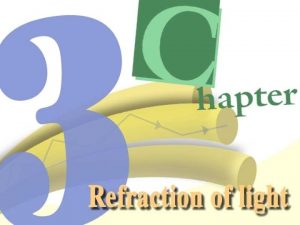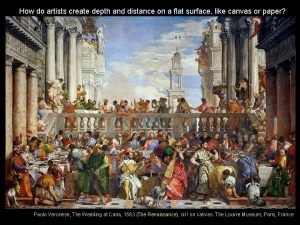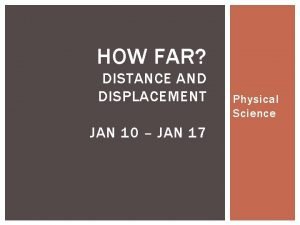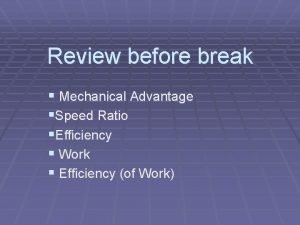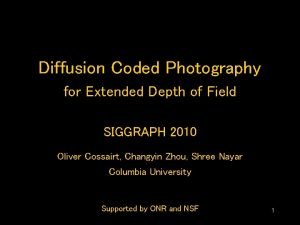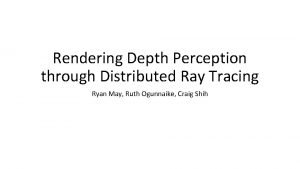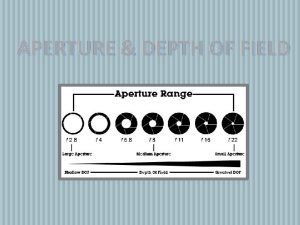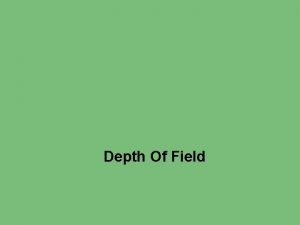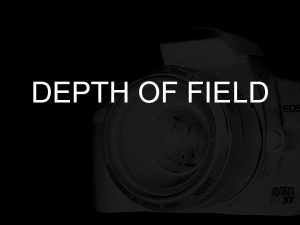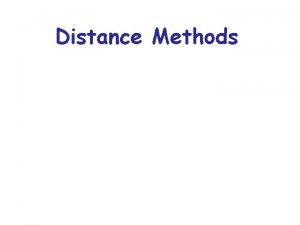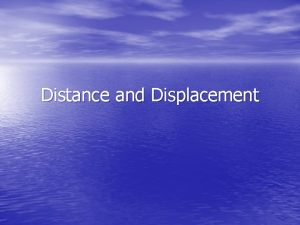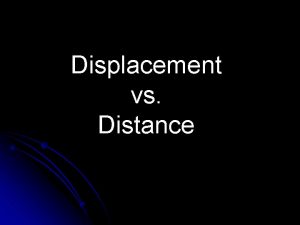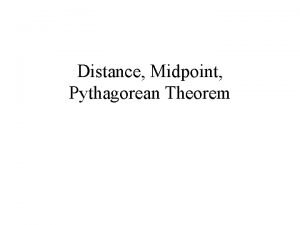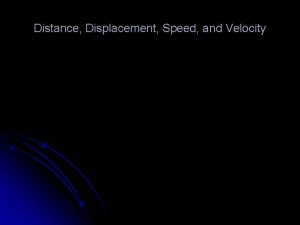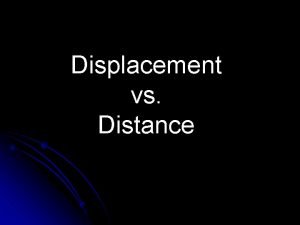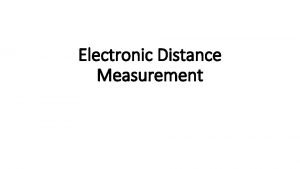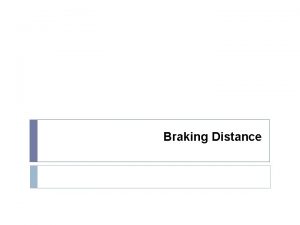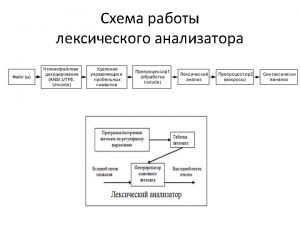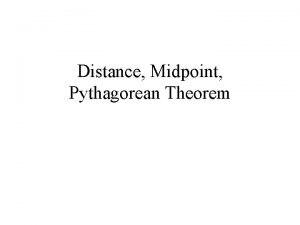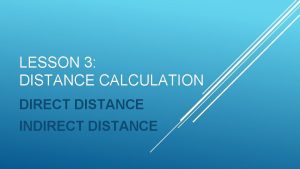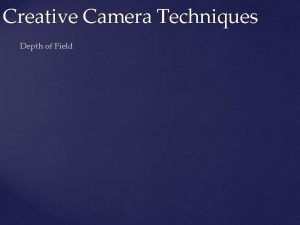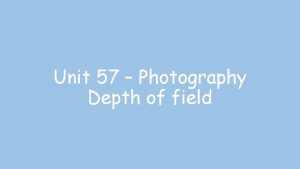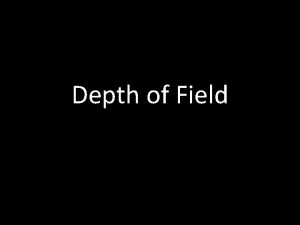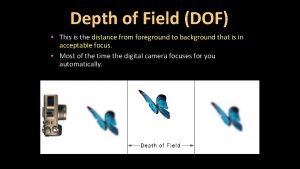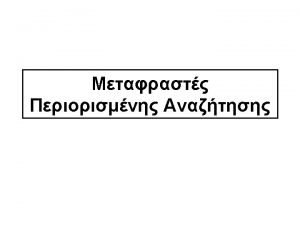Depth of Field Depth of Field The distance































- Slides: 31

Depth of Field

Depth of Field § The distance range between the nearest and farthest objects that appear in acceptably sharp focus. § Depth of field depends on the lens opening, the focal length of the lens, and the distance from the lens to the subject.




The General Principles that Govern Depth of Field Greater depth of field Less depth of field Wide-angle lenses Telephoto lenses High f-stop(small aperture) Low f-stop (wide aperture) Subject far away from camera Subject close to camera

F-2. 8 F-5. 6 F-11 F-22


DOF and size of CCD chip or film frame ・First is a 35 mm movie camera. ・Second is a 16 mm movie camera (or a 2/3 inch broadcasting camera). ・Third is a 1/3 inch pro-consumer DV (Panasonic DVX 100, Panasonic HVX-200) ・Forth is a consumer 1/4 inch mini -DV camera (Canon GL 1, Sony TRV 900)

Film vs. Video

Film vs. Video

Selective focus Blue - directed by Krzystof Kieslowfski



Type of Close-ups § Cut-in close-up: a magnified portion of the preceding large scene. The audience’s curiosity should be satisfied by bringing them closer, otherwise the viewer may lose interest. § Cut-away close-up: is related to, but not a part of, the previous scene. Cut-away closeups may be filmed from three camera angles: Objectively, Subjectively and pointof view.

The Power of Close-ups § A properly chosen, expertly-filmed, effectively-edited close-up can cause dramatic impact and visual clarity to the event. § Close-up should be considered from both visual and editorial standpoints. § Important in theatrical production: camera angle, image size and lighting of theatrical close-ups.

The Double Life of Veronique by Krzysztof Kieslowski

11'09'01 -U. S. A. by Sean Penn

Demo 16 mm Camera Éclair NPR

Film Loading


The Path Through the Camera

The Shutter

Reasons to Change the Shutter Angle

Camera Movement 1. 2. 3. 4. 5. 6. 7. Pans Tilts Dolly Shots Hand-held shots Crane Shots Zoom Lenses The Aerial Shot



Demo § Camera movement: Tracks and skateboard dolly § Outdoor lighting demo: reflector and diffusion

Project #2 § Available Light Project (Due Oct. 12) (KODAK VISION 2 250 D/7205) § Develop a narrative story that’s taken place either interior of exterior. Shoot 400 feet of film using available light only. You are encouraged to combine with camera movements. § Two group of six.

Reading § § § P 173 -195 Close-ups; (Five C’s of Cinematography) Malkiewicz p 19 -26; Optics, (Cinematography) Steven Bernstein p. 55 -62; Depth of Field (Film Production)

Hyperfocal Distance § The hyperfocal distance is the point of focus where everything from half that distance to infinity falls within the depth of field.
 Semi circular glass block critical angle
Semi circular glass block critical angle The use of depth and distance on a flat surface
The use of depth and distance on a flat surface What is the distance between distance and displacement
What is the distance between distance and displacement The ratio of input distance to output distance
The ratio of input distance to output distance Extended depth of field photography
Extended depth of field photography Factors affecting depth of field
Factors affecting depth of field Distributed ray tracing
Distributed ray tracing How does aperture affect depth of field
How does aperture affect depth of field Field signals ncc
Field signals ncc Thế nào là giọng cùng tên
Thế nào là giọng cùng tên Vẽ hình chiếu vuông góc của vật thể sau
Vẽ hình chiếu vuông góc của vật thể sau Phép trừ bù
Phép trừ bù Bài hát chúa yêu trần thế alleluia
Bài hát chúa yêu trần thế alleluia Hổ sinh sản vào mùa nào
Hổ sinh sản vào mùa nào Lời thề hippocrates
Lời thề hippocrates Thang điểm glasgow
Thang điểm glasgow đại từ thay thế
đại từ thay thế Quá trình desamine hóa có thể tạo ra
Quá trình desamine hóa có thể tạo ra Cong thức tính động năng
Cong thức tính động năng Thế nào là mạng điện lắp đặt kiểu nổi
Thế nào là mạng điện lắp đặt kiểu nổi Dạng đột biến một nhiễm là
Dạng đột biến một nhiễm là Bổ thể
Bổ thể Vẽ hình chiếu đứng bằng cạnh của vật thể
Vẽ hình chiếu đứng bằng cạnh của vật thể Phản ứng thế ankan
Phản ứng thế ankan Môn thể thao bắt đầu bằng từ chạy
Môn thể thao bắt đầu bằng từ chạy Khi nào hổ mẹ dạy hổ con săn mồi
Khi nào hổ mẹ dạy hổ con săn mồi Thiếu nhi thế giới liên hoan
Thiếu nhi thế giới liên hoan điện thế nghỉ
điện thế nghỉ Một số thể thơ truyền thống
Một số thể thơ truyền thống Biện pháp chống mỏi cơ
Biện pháp chống mỏi cơ Trời xanh đây là của chúng ta thể thơ
Trời xanh đây là của chúng ta thể thơ
